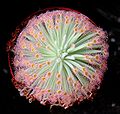| Drosera subg. Lasiocephala | |
|---|---|
 | |
| Drosera derbyensis , a member of subgenus Lasiocephala | |
| Scientific classification | |
| Kingdom: | Plantae |
| Clade: | Tracheophytes |
| Clade: | Angiosperms |
| Clade: | Eudicots |
| Order: | Caryophyllales |
| Family: | Droseraceae |
| Genus: | Drosera |
| Subgenus: | Drosera subg. Lasiocephala (Planch.) J.Schlauer |
| Type species | |
| D. petiolaris | |
| Species | |
Drosera banksii Contents | |
| Synonyms | |
| |
Drosera subg. Lasiocephala, sometimes collectively known as the petiolaris-complex, [1] is a subgenus of 14 species in the genus Drosera . These species are distinguished by their subpeltate to peltate lamina. [2]











